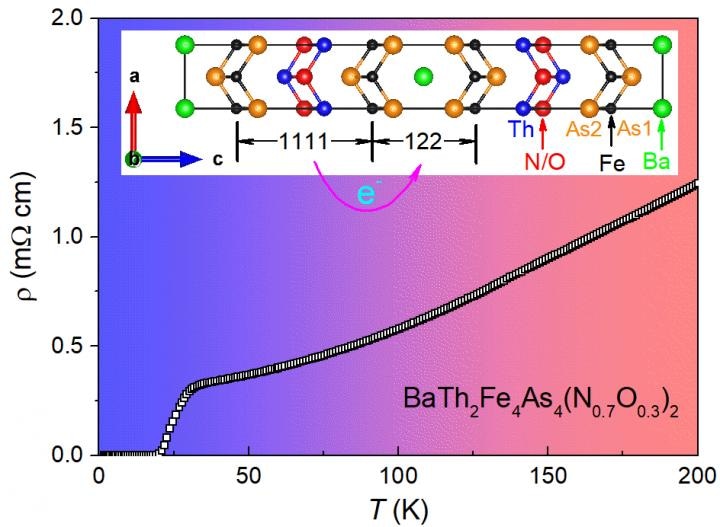May 17 2019
In the past 10 years, iron-based superconductors, also known as IBSCs, have attracted continuous research attention, which can be partly attributed to the discovery of new IBSCs one after another in the previous years.
 Temperature dependence of electrical resistivity for the BaTh2Fe4As4(N0.7O0.3)2 sample, indicating a superconducting transition at 30 K. The zero-resistance temperature is 22 K. The inset shows the crystal structure projected on the ac plane. The two constituent structural blocks, named “1111” and “122”, respectively, are marked, and the inter-block charge transfer is shown by the arrow. (Image credit: Science China Press)
Temperature dependence of electrical resistivity for the BaTh2Fe4As4(N0.7O0.3)2 sample, indicating a superconducting transition at 30 K. The zero-resistance temperature is 22 K. The inset shows the crystal structure projected on the ac plane. The two constituent structural blocks, named “1111” and “122”, respectively, are marked, and the inter-block charge transfer is shown by the arrow. (Image credit: Science China Press)
However, at present, the investigation of IBSCs is turning out to be increasingly difficult. A group of researchers from Zhejiang University has come up with a new structural design approach for the exploration of IBSCs (H. Jiang et al., China Phys. B, 2013, 22:087410), from which they were able to locate a sequence of hole-doped IBSCs with double FeAs layers in the recent past. But, until now, the electron-doped analog has not been achieved.
BaTh2Fe4As4(N0.7O0.3)2 is the recently discovered electron-doped IBSC. It is an intergrowth compound of electron-doped ThFeAsN0.7O0.3 and un-doped BaFe2As2, as shown in the above image. In order to produce the novel superconductor, nitrogen has to be partly substituted with oxygen as in the case of BaTh2Fe4As4(N0.7O0.3)2. For example, BaTh2Fe4As4N2—the oxygen-free phase—cannot be prepared despite the lattice matching. The synthetic process, thus achieved, is, in fact, a redox reaction, BaFe2As2 + 2ThFeAsN0.7O0.3 = BaTh2Fe4As4(N0.7O0.3)2, indicating a major role of inter-block charge transfer in the stabilization of the intergrowth structure. It must be noted that while identical iron atoms are shared by both the constituent structural blocks, they contain crystallographically varied arsenic atoms, as a result of the charge transfer.
Even though the novel superconductor is isostructural to the earlier “12442-type” equivalents, it exhibits contrasting physical and structural characteristics. Firstly, within the FeAs layers, the structural details are completely different from the structural details of hole-doped 12442-type IBSCs, yet analogous to a majority of the IBSCs doped with electrons. Secondly, the Hall-effect measurement reveals the negative Hall coefficient in the entire temperature range, and due to the substitution of oxygen, the Hall coefficient values are seen to be consistent with the electron doping level. Thirdly, the superconducting characteristic, for example, the specific-heat jump and upper critical fields are close to a majority of the electron-doped IBSCs.
The latest double-FeAs-layer IBSC has a zero-resistance temperature of 22 K and an onset resistive transition temperature of 30 K. Correspondingly, the specific-heat data and magnetic susceptibility propose two transitions, with the bulk superconductivity appearing at 22 K. The outcome is in contrast with ThFeAsN0.85O0.15—the single-FeAs-layer equivalent with the same level of doping. Above1.8 K, the latter does not exhibit superconductivity.
The crucial role of the inter-block charge transfer shown here appears to be insightful, which might be useful for studying broader-layered materials in addition to the layered IBSCs.